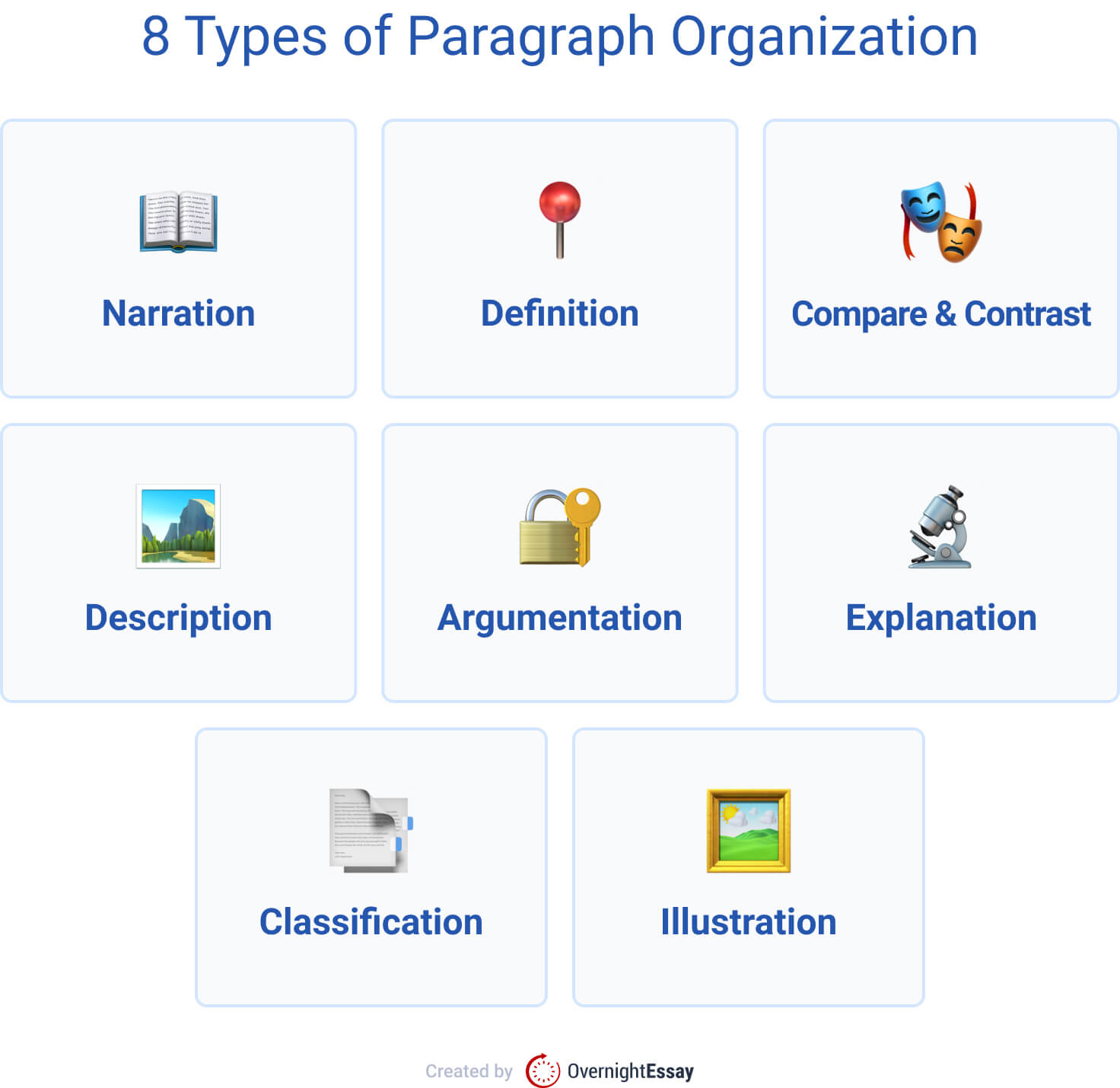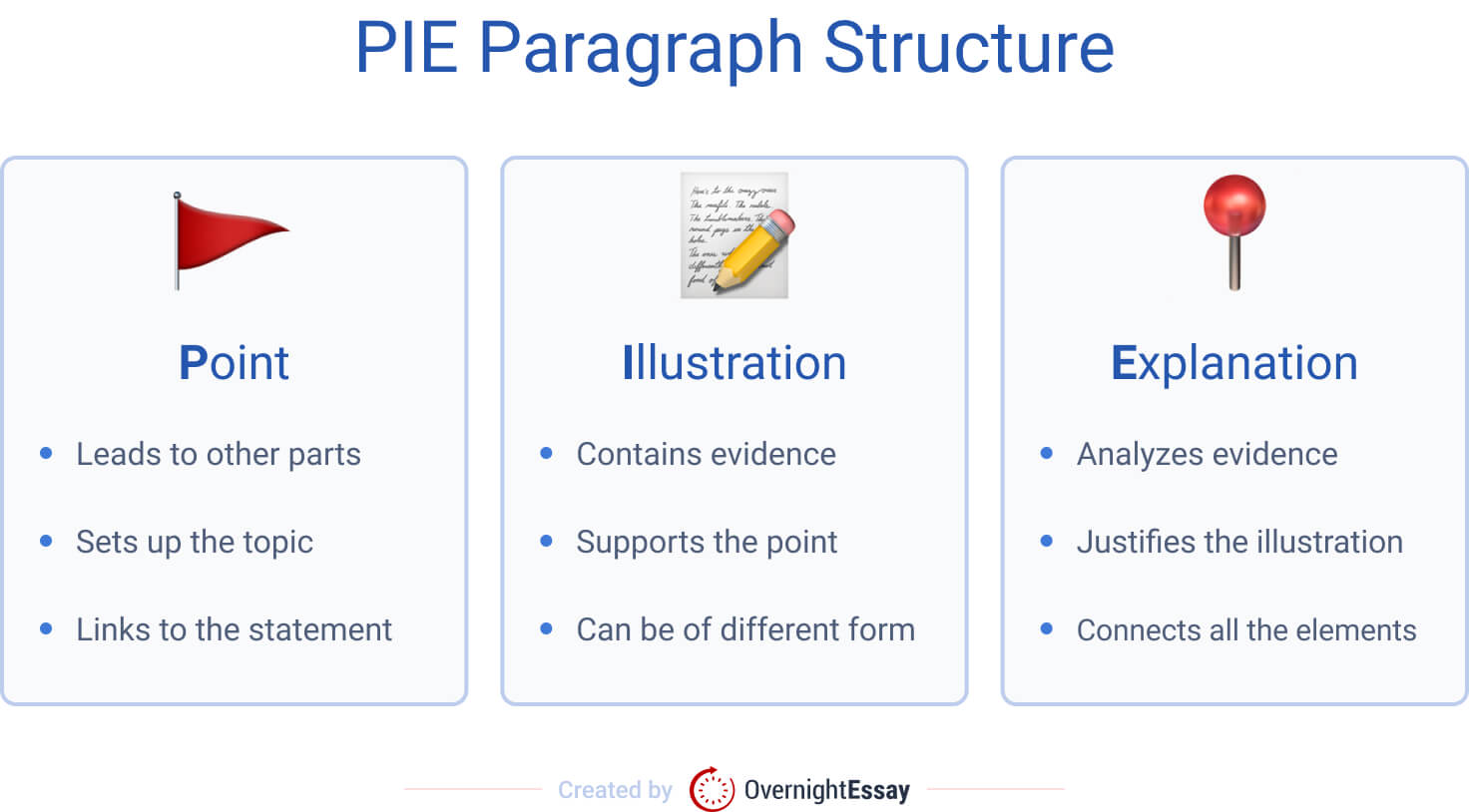
A lot has been said about organizing a text into paragraphs. But what about organizing paragraphs themselves? How to outline a paragraph? How long can it be?
Our team has done its best to get you acquainted with the parts of a paragraph. From this article, you’ll also learn about paragraph format and methods of building different types of paragraphs. You will also learn about helpful PIE paragraph structure. Knowing how to construct each paragraph properly, you can make the paper more solid.
💾 Paragraph Format
Logically interconnected sentences comprise what is called a paragraph. The latter includes three components: Topic, starting sentence;Body sentences;Concluding sentence that smoothly connects one paragraph to another.
The parts of a paragraph mentioned above allow it to support a particular idea. If a paragraph is constructed this way, readers get a clear sight of an author’s vision.
Below, you’ll discover more about a paragraph composition, its length, and various types of organization.
How Long Can a Paragraph Be?
There’s no onсe-for-all-time answer to the question “How many words are there in a paragraph?”. It depends on different factors: the type of paper and your intentions concerning the paragraph volume.
- However, the standard paragraph recommended length is around 100-200 words. In sentences, it would be from 3 to 5 or more.
Mind that opening and concluding paragraphs can be shorter than other ones. Besides, in some academic works, the length can be extended due to the depth of the paper.
Parts of a Paragraph
Most likely, you have an idea of a basic essay structure. It includes an introduction, body, and a concluding paragraph.
Would you be surprised if we told you that a paragraph structure doesn’t differ from that much? It should have the same three logical parts. In this case, these are sentences, not sections.
Let’s have a closer look.
I. Topic Sentence
The topic sentence is an introductory sentence that gives a reader a hint about the content. It contributes to building a consistent paragraph structure.
In the beginning, the topic sentence must be general. However, it should be narrower than your thesis statement. Use our thesis maker to see what it can look like. Make sure that your topic sentence contextualizes a fact and that the following sentences support it.
II. Supporting Sentences
In this part, develop ideas from the topic sentence. Supporting sentences perform this function. They elaborate on the content making it more complete.
For instance, supporting sentences often include either details or examples. That allows the reader to plunge into the topic deeper and get the point. Mind that there should be approximately 2-4 logically built supporting sentences per paragraph.
III. Concluding Sentences
The last but not the least essential constituent in a paragraph are concluding sentences. It would be correct to assume that concluding sentences wrap up the paragraph’s ideas into unity. Concluding sentences shouldn’t include new facts. Summarize it all up and prepare the reader for the next part. Check our free summary generator to make the best concluding sentences.
Here are a couple of tips for you:
- Use transition words and phrases (as a result, thus, finally, lastly, for this reason).
- Restate the topic sentence.
💡 How to Organize a Paragraph: 8 Types
An exciting fact about paragraphs: they are different and perform various functions. Each type of paragraph structure looks much like a mini-version of a respective essay type. You can use certain ones to meet the goals of a particular essay.
Let’s see.

1. Paragraph Organization – NARRATION
A narrative paragraph is an interesting one. It supposes a kind of storytelling. Open up a story about your subject and tell it in a consistent, chronological way. It’s a great idea to insert a real-life situation into the parts of a paragraph and render events in detail. This involves the reader.
Read more about how to write a narrative paragraph and four types of narrative writing.
2. Paragraph Organization – DEFINITION
If you want to get your ideas across with the help of some terms, a definition paragraph is a proper space to do it. Reveal the essence of a concept or explain the meaning of some notion. If necessary, expose the steps of a process. The main goal here is to illustrate how something works to make it clear to the reader.
Here’s a very simple explanation of what is a definition paragraph.
3. Paragraph Organization – COMPARE & CONTRAST
Compare & contrast paragraphs are good when you need to compare two or more objects or phenomena. For example, you need to compare two different novels. In that case, a topic sentence will introduce these novels. Body sentences will discuss the similarities and differences. Finally, concluding sentences will summarize and interpret what was discussed.
Explore this article and learn how to organize compare-contrast paragraphs.
4. Paragraph Organization – DESCRIPTION
If you aim to provide broader, more detailed information about something, use this paragraph structure. It can be beneficial when you need to transmit an experience unknown to readers. You can thoroughly describe how something looks, tastes, or feels.
Here’s more information on writing a descriptive paragraph and excellent tips on descriptive paragraph organization.
5. Paragraph Organization – ARGUMENTATION
This type of paragraph will assist you in standing for or against a particular point of view. Each of the argumentation paragraphs should reflect and back up one idea. It works just like a regular argumentative essay. A topic sentence introduces an argument and opinion. Body sentences provide the ground for your position. In concluding sentences, you are supposed to reformulate the position.
Learn more about argument paragraph organization and look for some great samples.
6. Paragraph Organization – EXPLANATION
In an explanation paragraph, provide the reader with the information concerning the process. Explain how the subject under the question works and expose the details so that the audience doesn’t have any questions. You also have to give directions and the results of some processes to clarify it.
Read how to build an explanation paragraph properly.
7. Paragraph Organization – CLASSIFICATION
If you aim to divide subjects into groups to light their peculiarities, use this paragraph structure. Separate one class from another, explaining the differences. Organization of the information depends on particular goals. Thus, to sort items properly, base yourself on the assignment.
Check out this awesome guide on writing a classification paragraph; and some organization tips.
8. Paragraph Organization – ILLUSTRATION
Let’s say you’re stating a particular opinion in your paper. The subject might be controversial, so you need solid evidence to back up your point. Illustrations, or real examples – are what you need in that case. Provide some life-based instances to be persuasive to the max.
Visit these websites for more details: How to Write 1 Well Developed Illustration Paragraph and Illustration paragraphs guide & tips.
🥧 PIE Paragraph Structure
The PIE method of paragraph organization can be extremely helpful in academic essay writing. Let’s figure out how it works.
PIE stands for Point, Illustration, and Explanation. These are three concepts comprising the structure. With the help of these, you can conduct analysis and provide examples most efficiently.
Below, you will find detailed information about the PIE method and PIE paragraph examples.
The PIE Strategy for Developing a Body Paragraph
As we’ve said, the PIE strategy is a tool for creating a proper body paragraph.
*Mind that it applies to the body only: the introduction and conclusion cannot be PIE-structured.
With a PIE strategy, the body paragraph becomes thoroughly structured. Once you know where a particular part should be, writing becomes much more manageable. Thus, introduce a critical point, illustration, and explanation in the correct order – this way, you get a perfect body paragraph.
PIE Paragraph Structure
We have come to the most exciting part of the PIE paragraph format – its constituents. There are three of them. Let’s dig a bit deeper now.

- The Point is a crucial idea of the whole paragraph that serves as a foundation for other parts. The Point sets up the topic to touch upon in the paragraph. Mind that it has to be linked to a thesis statement.
- The Illustration should contain pieces of evidence for the stance. There are different ways to draw those: quotations, statistics, personal experience – anything that helps you back up your point.
- The Explanation is where you insert some analysis. It reveals the grounding for why you’ve chosen those exact illustrations from the last part. The explanations show the relations between all the rest elements: how the illustration connects to the thesis and point.
PIE Paragraph Example
To understand the PIE method, it is better to see an example. We are going to show you one!
Let’s imagine we are writing an essay on water pollution. Our thesis statement is that water is vital for all living beings on Earth, and we should learn how to use it wisely.
As for the Point, we restate the thesis. It can be formulated as follows: Each creature on the planet needs water to live, so it’s essential to preserve and spare water resources. Then, we need to provide some evidence. The Illustration gives space for it: Scientists say that a human being consists of 80% of water. Besides, a person can stay alive only about 10-14 days without consuming liquid. We need to stay hydrated, as well as animals and plants. At the same time, statistics say that more than a billion people worldwide suffer from water shortages. Even more, people experience negative effects from consuming low-quality water. For instance, we cannot drink tap water in my native town now as we used to just a few years ago. The reason is that water is polluted with chemicals and can bring harm to health. The Explanation demands that we create a link between the Point and Illustration, providing some analysis: It’s shocking how people treat water despite being aware of its significance. They let the industrial waste leak in the water reservoirs and poison them. People use water resources intensely. With overpopulation, the issue of water scarcity grew even more severe. Each year our current freshwater resources become dirtier due to contaminants of all kinds. There is water conserved in glaciers, but it’s out of access. The situation needs urgent actions and new solutions for water preservation.
📜 5 Rules on How to Organize a Paragraph
At this point, let’s wrap up the discussion and go through the most vital aspects of organizing a paragraph.
- Define which paragraph type you are going to need in your paper. To accomplish it, examine the assignment and get the idea of an essay type. Use our list to navigate through paragraph types.
- Explore some information about the PIE method of paragraph structuring. It will help you outline a body paragraph most efficiently.
- State a paragraph’s Point – make sure it is connected to a thesis statement. Introduce the general topic in a starting sentence.
- Insert good pieces of evidence in body sentences: this is the time for the Illustration. Take your chance to sound confident and persuasive in your essay.
- Put your efforts into writing an Explanation because you should provide an accurate analysis of what you wrote before. Besides, you also have to glue everything up with the help of this element.
Now, you can create any type of paragraph and make it consistent to the max.
Don’t forget to proofread your paper and put in the corrections if needed! We wish you good luck!